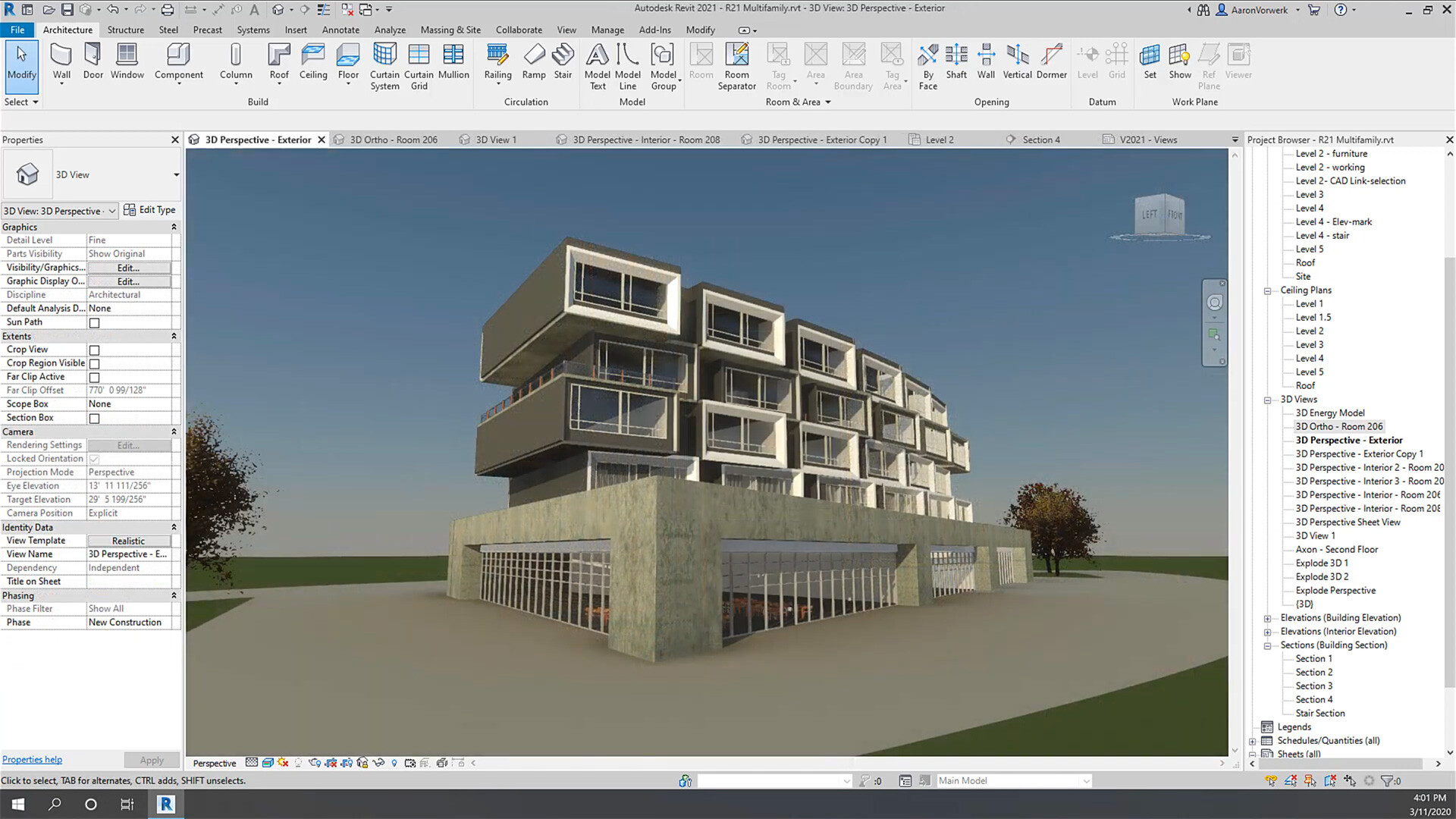Top Skills & Training to Become an Architectural Designer

Table of Contents
This guide outlines essential urban design skills every architectural designer needs, ranging from conceptual thinking and BIM proficiency to collaboration, sustainability, site analysis, and communication. It also explains the role of architectural designers, required training, and top certification courses that help professionals strengthen their design capabilities and advance their careers in the AEC industry.
If you have a knack for designing or you’re looking to upskill as an architectural designer, you have landed at the right place. In this guide, you will understand who is an architectural designer, what he does, and how to become one. You’ll also learn about the critical skill sets required to excel in this field and discover the best architectural design training courses currently making waves.
Understanding the Role of an Architectural
Designer
Architectural designers solve design problems and create functional and visually pleasing environments. Their role and contribution are critical in turning conceptual ideas into tangible structures that significantly improve the way we live, feel and interact with our surroundings.
Who is an Architectural Designer?

An architectural designer supports building design from early concepts to detailed drawings and coordination. Strong urban designer skills and BIM literacy help them translate client goals into functional, code-compliant spaces that are buildable and visually cohesive.
An architectural designer is a professional who conceptualises, develops design solutions, and oversees the construction of buildings and infrastructures. Architectural designers meet clients, understand their requirements, preferences, and budgets and then formulate layouts that match their project goals. They work for architectural firms, construction companies, government bodies, or have their own practices. They often work closely with contractors, civil engineers, project managers, and other stakeholders to fulfil the functional, visual, and sustainable needs of a project. Within the architecture industry, architects can specialise in a particular building type, such as residential, industrial, commercial, heritage, or public buildings.
Architectural designers must ensure that the construction process adheres to quality, public safety, and environmental protection standards. This requires in-depth knowledge of these factors, along with strong design skills. You need to be familiar with architectural principles, codes, and standards and be proficient in software like AutoCAD, Revit, and SketchUp. You must be able to create and interpret drawings, models, and specifications effectively and follow safety standards outlined by the government.
Additionally, a good architectural designer should have:
- A keen eye for design, material, colour, and detail
- A strong sense of spatial awareness and proportion
- An innovative approach to problem-solving
Now that we understand who an architectural designer is, let's delve deeper into their roles and responsibilities.
Also Read: Architecture Thesis Topics: A Comprehensive List of 30 Topics to Pick From
What Does an Architectural Designer Do?
Architectural designers handle ideation, site analysis, design development, material selection, and cross-team coordination. Urban designer skills also include sustainability thinking, clear communication, and BIM-based collaboration to reduce errors and speed decisions. Their responsibilities can vary based on the size and scope of a project, but typically include:
1. Ideation and Conceptual Development
Architectural designers communicate with clients to understand their needs, preferences, and budgets to develop the initial design concepts. This includes creating sketches and mood boards and visualising the overall look and feel of the project.
2. Site Analysis
They analyse the site, considering factors such as topography, climate, and existing surroundings to determine the most suitable approach and ensure the design fits within the environment.
3. Design Development
Architectural designers create detailed plans and drawings, often using computer-aided design (CAD) or Building Information Modeling (BIM) tools. This includes floor plans, elevations, sections, 3D renderings, and walk-throughs to visualise the final outcome.
4. Material Selection
With the client’s consent, they choose appropriate construction materials, considering factors like durability, aesthetics, sustainability, and cost. This involves researching and specifying materials for different parts of the building, such as walls, floors, roofing, etc.
5. Collaboration
Architectural designers often collaborate with other professionals, including civil engineers, contractors, interior designers, and furniture designers, to ensure the project is feasible, functional, and aesthetically pleasing. Effective communication and coordination with them are crucial to the project's success.
6. Sustainability
Many architectural designers have started focusing on incorporating sustainable design principles into their projects. These include optimising energy efficiency, using eco-friendly materials, recycling furniture, and considering the building's environmental impact.
7. Compliance and Permits
They ensure that the design complies with local building codes, zoning laws, and regulations. This may involve preparing and submitting permit applications and working with regulatory authorities to gain necessary approvals.
8. Project Management
They may oversee the construction process, ensuring that the project is executed according to the design plans and within the established timeline and budget. This can involve site visits, coordinating with contractors, and resolving any issues that arise during construction.
9. Client Interaction
Architectural designers maintain ongoing communication with clients, providing updates, addressing concerns, and incorporating feedback to ensure the final design meets the client's vision and requirements.
Also Check out: 15 Architectural Designer Interview Questions to Land High-Paying Jobs
Key Skills of an Architectural Designer
Key skills blend technical tools and human strengths. Technical ability includes BIM, 3D modeling, documentation, and data handling, while soft skills include teamwork, problem-solving, and client communication. These urban design skills improve project outcomes and employability.
Technical Skills
An architectural designer with BIM expertise requires a comprehensive set of technical skills to effectively manage and execute complex building projects. These skills span across various domains, enabling the designer to utilise BIM technology to improve design quality, enhance collaboration, and increase project efficiency. Here are the essential technical skills needed:
- Software Skills:
The type of BIM software and skill level required depends on the specific role and responsibilities of an architectural designer. Generally, higher positions with more responsibilities demand more advanced software skills. For all BIM professionals, proficiency in 3D modelling, visualisation, and cloud collaboration is fundamental. You must create and manage a data-rich 3D model that is shareable and manageable by different project parties to truly work with BIM. Today's software advancements also enable innovative and organic designs through visual programming in BIM software. For instance, Revit offers plugins like Dynamo and Rhino.Inside for parametric modelling and Navisworks for clash detection, project review, and coordination.
Also Read - Why Architectural Designers Should Master Grasshopper + Dynamo?
- Data Management Skills:
Effective data management is crucial, as a building information model contains extensive embedded information. Various stakeholders utilise different aspects of the model to optimise decision-making. Advanced technologies like AR (Augmented Reality) and VR (Virtual Reality) are increasingly used for presentation and visualisation, allowing stakeholders to experience the project virtually before construction begins.
- Presentation Skills:
Given the extensive information in a BIM model, a clear presentation is crucial for stakeholder understanding and use. Besides renders and visualisations, deliverables also include data embedding, scheduling, cost estimation, and clash detection. The goal is to provide the right information to the right people for effective decision-making. Thus, presenting information clearly in oral, visual, or written formats is essential, highlighting the need for strong communication skills in architectural designers.
Soft Skills
- Problem-solving and Critical Thinking
- Addressing complex design challenges with innovative solutions.
- Analysing project data to make informed decisions and improve design outcomes.
- Clear Communication
- Ability to articulate design concepts, project goals, and technical details clearly and effectively to clients, team members, and stakeholders.
- Proficiency in writing clear, concise reports, emails, and documentation to ensure everyone is on the same page.
- Continuous Learning and Adaptability
- Staying updated with the latest BIM technologies and industry trends.
- Adapting to new tools and methodologies as the field evolves.
- Flexibility to adapt to changing project requirements and industry trends, thereby efficiently managing deadlines, resources, and priorities.
- Collaboration and Teamwork
- Working effectively with various professionals, including engineers, contractors, and interior designers, to achieve project goals.
- Leadership and Team Management
- Ability to lead and mentor junior team members.
- Managing and coordinating BIM workflows within a team setting.
Importance of Architectural Designers in the Job Market
Architectural designers are important for creating innovative, sustainable, and functional built environments, making them invaluable in the job market. Here are a few aspects that they highly influence:
Innovative Design Solutions: They bring creativity and innovation to the table, creating aesthetically pleasing and functional spaces that meet the needs of clients and communities.
Sustainable Practices: With a growing emphasis on sustainability, architectural designers integrate eco-friendly practices and materials into their designs, contributing to the creation of green buildings and reducing the environmental impact of construction.
Technology Integration: Proficient in the latest design and modelling software, including BIM, architectural designers enhance project efficiency, accuracy, and collaboration among various stakeholders, leading to more successful project outcomes.
Economic Impact: Architectural designers contribute to the economy by driving the construction industry, creating jobs, and supporting related sectors such as real estate, manufacturing, and interior design.
Urban Development: They play a key role in urban planning and development, helping shape the physical environment of cities and communities, improving the quality of life for residents.
Client Satisfaction: By understanding and translating client needs and desires into tangible designs, architectural designers ensure higher levels of client satisfaction and project success.
Compliance and Safety: They ensure that designs comply with building codes, regulations, and safety standards, protecting the well-being of occupants and the public.
How to Become an Architectural Designer?
To become an architectural designer, build a foundation through education, internships, and a strong portfolio. Add BIM training, site analysis practice, and communication skills. Strengthening urban designer skills helps you qualify for better roles across the AEC industry. If you’ve ever wondered how to become an architectural designer, here are the general steps you can follow:
1. Complete Your Education
- Earn a bachelor's degree in architecture or a related field.
- Develop skills like 3D modelling, design principles, building codes and regulation, and project management.
2. Gain Practical Experience
- Enrol in an internship at an architectural firm for practical experience. Gain hands-on experience through site visits and brush up your software skills. Improve your communication and problem-solving skills by effectively interacting with clients, colleagues, and site workers. This knowledge and experience will place you in a good position when you start working as an architectural designer.
- Participate in various design projects to build your portfolio and skills.
3. Build Your Portfolio
- Your portfolio serves as your professional calling card, showcasing your skills, best designs, and technical drawings to prospective employers. Join architectural associations, attend workshops, and engage in continuous learning to stay up-to-date in the field.
4. Apply for Jobs
- Update your portfolio and resume and create a strong LinkedIn profile to showcase your recent achievements and suitable skillset for the desirable job requirements. Look for job openings, use your network, and reach out to architectural firms and companies where you want to work.
Also Read: Top 7 Places to Learn BIM (Building Information Modelling) in India
Top 5 Architectural Design Training Courses With Certification
To excel in on-site or remote architectural design roles, upskilling is key. Participating in these courses can significantly enhance your expertise and increase your earning potential as an architectural designer. Let's explore some of the top programs available for architectural designers.
1. BIM Professional Course for Architects V2.0 by Novatr
Duration: Nine Months
Mode of Study: Online
Fee: ₹ 2,45,000 (Total Program Fee)
The BIM Professional Course for Architects is one of the most sought-after architectural design training courses, offering in-depth insights into BIM processes, workflows, and tools. Participants learn 15+ BIM software and gain hands-on experience by practising their skills on 3+ RIBA and ISO projects. This ensures a well-rounded education in both technical and collaborative skills. This program combines career-oriented learning, live sessions, and innovative boot camps, making it a top choice for acquiring industry-relevant skills. The course provides placement assistance, helping participants explore better career opportunities.
How will this course help you land an architectural job?
This course provides a comprehensive BIM training, hands-on experience with industry-standard projects, and expert guidance. It develops essential technical and collaborative skills, significantly boosting employability with a proven track record of higher salaries and job placements. Additionally, the course offers placement assistance, helping participants secure better architectural job opportunities.
Also Check out: Everything You Need to Know About BIM and Architectural Visualisation
2. Advanced Revit & BIM Certification Course By Kaarwan
Duration: Four Months
Fee: INR 62,999 - 72,999
Mode of Study: Online
The Kaarwan Advanced Revit BIM Certification Course is an extensive online course designed for architectural designers who want to deepen their skills in BIM and Revit, emphasising the significance of technical drawing in the architectural field. The curriculum is designed to advance one's competencies in creating detailed models, enhancing project visualisation, and streamlining the workflow of architectural projects. It prepares learners to tackle practical challenges in the industry. The course teaches the basics of 3D modelling and progresses into the creation of parametric models. It also covers the topics of adaptive families, scheduling, quantification, efficient documentation, and budgeting. Further, the program imparts knowledge about sustainable design and energy-efficient architecture, delivered through industry experts and fundamentals of portfolio, tips, tools, and resources for a better workflow.
How will this course help you land an architectural job?
The course equips architectural designers with advanced skills in BIM and Revit, focusing on technical drawing, 3D modelling, parametric models, and efficient project documentation. It addresses practical industry challenges and covers sustainable design and energy-efficient architecture. Taught by industry experts, the course improves workflow and provides valuable portfolio tips and resources, making graduates more competitive and better prepared for architectural job opportunities.
3. Revit Architecture and V-Ray By Grey Edge
Duration: 84 hours
Fee: Not Defined
Mode of Study: Online
Grey-Edge offers the Revit Architecture Comprehensive Course, designed for architects, civil engineers, interior designers, and AutoCAD draughtsman seeking to master Revit BIM technologies. This course equips participants with essential skills for creating detailed models and visualisations using Revit Architecture and V-Ray. It emphasises practical applications such as BOQ and BOM preparation, shop drawings, and construction document (CD) sets. This technical training ensures proficiency in BIM, preparing participants for roles as Revit technicians or BIM modellers across various sectors.
How will this course help you land an architectural job?
The course provides architects and engineers with essential BIM skills using Revit Architecture and V-Ray. It focuses on creating detailed models, visualisations, and practical applications. This technical training ensures proficiency in BIM, preparing participants for roles as Revit technicians or BIM modellers, thereby enhancing their employability in the architectural industry.
4. BIM Ready Complete Course by TecnoStruct Academy
Duration: Eight Months
Fee: INR 2,00,000
Mode of Study: Online/Offline
BIM Ready Complete Course by TechnoStruct Academy is specifically designed for architectural designers. It offers a range of comprehensive BIM courses for aspiring architects seeking to excel in the digital aspects of architectural design and construction. The course teaches over 21 BIM software and plugins, enabling architectural designers to become experts in the field. Divided into 14 modules, it covers parametric modelling, generative design, and Computational Design, addressing both fundamental and advanced concepts. The curriculum also includes 4D and 5D BIM, enhancing efficiency in building design and construction. Courses like BIM-Ready+, BIM-Ready Complete, and specialised tracks in architecture and structure are designed to equip students with essential skills for technical drawing and modelling. This training is vital for those aiming to advance their careers by mastering cutting-edge technology and workflows integral to modern architectural projects. Led by top practising professionals, the course offers placement assistance, ensuring participants can explore better career opportunities.
How will this course help you land an architectural job?
The course equips architectural designers with expertise in over 21 BIM software and plugins through 14 comprehensive modules. Taught by top professionals, it provides essential skills for technical drawing and modelling, and offers placement assistance, making graduates highly competitive for architectural job opportunities.
Also Read: How Revit is Used for Structure Design: A Comprehensive Overview
5. BIM in AEC Industry Using Revit by Skill Lync
Duration: Four Months
Fee: INR 40,000
Mode of Study: Online
The BIM in AEC Industry Using Revit course offered by Skill-Lync is designed to provide both working professionals and students with a comprehensive BIM understanding. The course begins with basic modelling and template creation, advancing to complex tasks such as developing parametric models and adaptive families. Participants also gain expertise in scheduling, quantification, estimation, energy calculations, and sustainable design analysis, preparing them to tackle real-world challenges effectively.
Guided by industry experts, this online course offers practical insights into the AEC (Architecture, Engineering, and Construction) industry. Learners can explore fundamental BIM concepts and various model authoring software, utilising powerful tools like Revit, Dynamo, and BIM 360. The curriculum equips learners with essential skills for creating accurate 3D BIM models, managing digital standards, and working on industry-relevant projects, making it an excellent choice for those looking to excel in architectural design and construction.
How will this course help you land an architectural job?
The course provides a comprehensive BIM understanding, covering basic to advanced modelling, parametric models, scheduling, estimation, and sustainable design. Taught by the best professionals in the industry, it offers practical insights into the AEC industry and hands-on experience with Revit, Dynamo, and BIM 360. This curriculum equips learners with essential skills, making them well-prepared for architectural job opportunities.
Also Read: What is BIM management? What does the career role involve?
Conclusion
The future of architectural design will prioritise inclusivity, accessibility, and individual well-being, fostering a holistic and human-centric approach to space creation. To achieve this, professionals need to adopt new tools and technologies, enhancing their creativity and technical precision.
If you aim to secure rewarding architectural design job opportunities, upskilling in BIM is a must. Consider the BIM Professional Course for Architects offered by Novatr to master BIM software, processes, and workflows. Participants have the chance to learn from industry experts and apply their knowledge to real-world capstone projects. Novatr also offers comprehensive placement assistance, helping you advance your career. Explore this course today!
Head to our Resources Page to learn more about architectural designers, career opportunities, and software.
FAQs
1) What do you need to be an urban designer?
To become an urban designer, you need design education, strong site analysis, and a clear portfolio. Learn BIM and 3D modeling, understand public space planning, and build communication skills to work with architects, engineers, and city stakeholders.
2) What skills are required for an urban designer?
Core urban designer skills include spatial planning, GIS basics, site research, concept development, and visual storytelling. Add BIM collaboration, clear documentation, and stakeholder coordination. Strong problem-solving helps you balance safety, mobility, sustainability, and community needs.
3) What are the qualities of urban design?
Good urban design is safe, walkable, connected, and easy to navigate. It supports comfort, identity, and public life through thoughtful streets, shading, landscape, and mixed-use planning. Strong accessibility and environmental planning improve long-term city performance.
4) What qualifications are needed to be a designer?
Most design roles need a bachelor’s degree in architecture, urban design, or a related field. Certifications in BIM, Revit, or visualization can strengthen job readiness. A polished portfolio and internship experience often matter as much as formal credentials.
5) What makes a good urban designer?
A strong urban designer blends creativity with evidence-based planning. They listen well, communicate clearly, and use site analysis to justify decisions. They also collaborate across disciplines, consider sustainability, and design public spaces that work for real users.

 Thanks for connecting!
Thanks for connecting!
.jpg)

.png)




